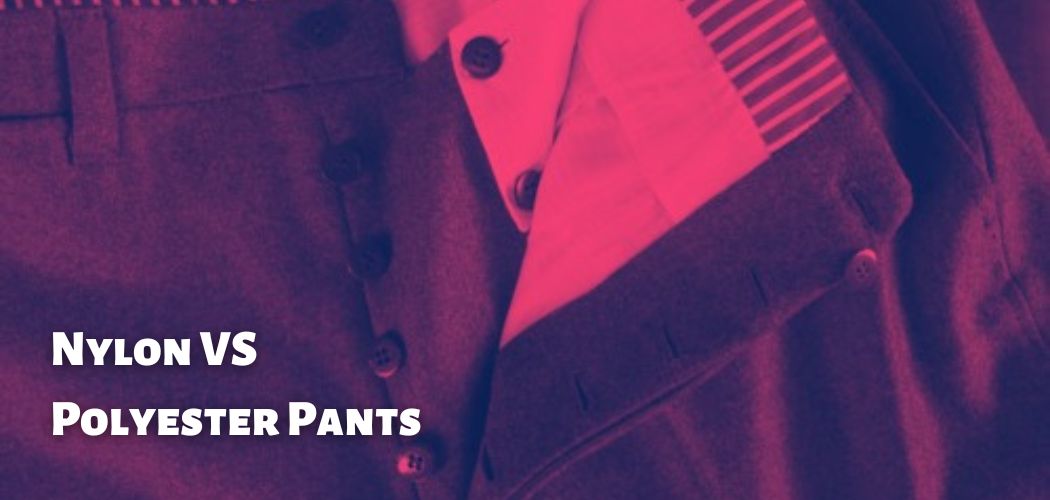Both nylon and polyester as textiles actually have a lot in common.
You will need to examine the materials under a microscope and think about their chemical makeup to recognise the little variations between these two synthetics.
Polyester is polymeric fabric and can also be called plastic.

This synthetic fabric is created via a procedure called polymerization, which combines monomers under pressure and heat to create a larger, stronger polymer.
Terephthalic acid and ethylene glycol are the two monomers typically used to make polyester.
Following polymerization, the plastic remelts and is extruded into long filaments.
To make a polyester mix, these filaments are coiled into thread or intertwined with the fibers of another fabric.
Polyester was created in the late 1930s, shortly after nylon was. Scientists rightly predicted that this incredibly durable and robust cloth will have a wide range of industrial applications.
Polyester was once popularized as double knit, a rough, heavy fabric.
The 1970s, a decade characterised by vibrant colours and bell-bottom pantsuits, saw the rise of this fabric in fashion.
The fabric sector developed quickly. Nowadays, polyester fabric is produced in a wide range of weights and textures, most of which are light and smooth.
Some firms now use recycled plastic to create polyester. By doing this, the environmental harm caused by producing this nonbiodegradable fabric is lessened.
However, recycling polyester is more expensive than producing it fresh.
Similar to polyester, nylon is a polymer created from petroleum by joining several monomers to form a long, unique polymer.
Adipic acid and hexamethylenediamine are the monomers used to make nylon.
To create the filaments that will comprise a thread, nylon polymers melt from bead-like granules into lengthy threads extruded through industrial nozzles.
The manufacturing procedures for both materials exhibit a great deal of similarity.
The weak hydrogen bonds binding the monomers together in nylon are a significant distinction, though. The polyester monomers are joined by incredibly strong bonds.
The first synthetic fabric, nylon, was created in the 1930s, just before polyester.

Since silk was sorely needed during World War II for military equipment like parachutes, its lightweight, smooth qualities immediately made it popular as a silk alternative.
Nylon made its way into common usage after the war, like several other military inventions.
In products like women’s underwear and stockings, it became a well-liked substitute for pricey silk.
Nylon is not biodegradable, just as polyester.
By using recycled resources to make the fabric, some moral manufacturers attempt to lessen the environmental consequences of producing this synthetic fabric.
Unfortunately, recycled nylon isn’t produced as frequently because this procedure is more expensive for nylon than for polyester.
Polyester is more adaptable and water-resistant than these textiles, which is the fundamental distinction between them. Although nylon is softer, it has fewer applications.
Similar manufacturing techniques are used to create these synthetic materials. These fabrics can be used alternatively in some items and have many similar qualities.
The textiles do, however, also differ significantly.
Breathability
Polyester lacks breathability, which causes many athletes to comment that it is uncomfortable to wear when working out.
Although its capacity to wick away moisture somewhat compensates for this drawback, polyester is now frequently combined with other fabrics, such cotton, to improve breathability.
In this regard, nylon performs worse. In hot or humid weather, it becomes clinging due to its lack of permeability and propensity to trap heat and moisture against the skin.
Durability
For durability, both textiles earn a perfect score. Since nylon has a higher strength to weight ratio than polyester cloth, it has a stronger tensile strength.

Nylon thus has a wide range of industrial applications outside the clothing business.
But polyester is also exceedingly robust. It is immune to UV rays, mould, water, heat, and other environmental stresses.
Comfortability
Initially, nylon was by far the gentler of the two textiles due to its light and smooth texture.
Polyester entered the clothing market slowly and unceremoniously as a thick, scratchy double-knit.
Nylon continues to be one of the most widely used materials for dresses, blouses, and undergarments today.
The fact that polyester typically produces finer threads and has a high thread count, however, is one of the advantages of modern manufacturing techniques.
This implies that polyester, which can be incredibly soft, creates ideal household products like bedsheets.
Resistance from Water
Both synthetic materials are only partially waterproof. Polyester does not, however, absorb moisture since it is hydrophobic.
Even though there are tiny air holes between the fibers in the fabric’s weave, water won’t bead on its surface; instead, it will pass through if there is enough pressure.
Contrarily, nylon does absorb moisture. Due to this, it also somewhat shrinks in extremely dry circumstances.
Both materials are excellent at wicking away moisture. Through the process of wicking, moisture is drawn from the body and dispersed throughout the fabric’s surface, where it can then evaporate.
Ultra-Violet Resistance
Polyester has excellent colour retention even in direct sunshine due to its high UV resistance. UV resistance is lower for nylon. Why is this crucial?
The majority of the time, this minor difference in UV resistance won’t be significant. In most other locations, nylon is very weather-resistant.
It will, however, fade considerably more quickly if you want anything that will stay outside for a long time, like a flag.
Flammability
Both fabrics have a high level of flame resistance, making them difficult to ignite. High heat, however, will cause both of them to melt, which can be extremely hazardous.
Both fabrics are frequently given special chemical treatments to increase their heat resistance.
Once it acquires a high enough temperature, polyester melts and burns simultaneously. Although it dissolves, nylon burns quickly. Either fabric’s melting plastic has the potential to be extremely harmful.

In spite of this, polyester is regarded as one of the safest products on the market. Since it takes more time to flame than many organic materials like cotton, it is also used for children’s sleepwear.
While polyester and nylon are both very similar, only polyester can be found in most pants. This is because nylon is still only used to make specific articles of clothing.
Both materials have their merits and demerits, so it is upto you to choose which one you favor based on its qualities.





